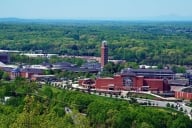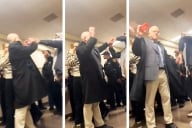You have /5 articles left.
Sign up for a free account or log in.
It wasn’t 9/11 and there were no serious injuries. But some University of North Carolina at Chapel Hill students are calling an incident Friday -- in which a recent graduate drove an SUV into a crowd of students and told authorities he acted to avenge the deaths of Muslims worldwide – an act of terrorism. The university is now weighing how to reassure students and to prevent a backlash against Muslims at Chapel Hill.
Tensions over religion and freedom have been running high at the university since last month, when The Daily Tar Heel published an original cartoon depicting Muhammad. Any depiction of Muhammad is considered a violation of Islamic theology by Muslims.
Six people, five students and a visiting scholar, were hurt, none seriously, Friday, when Mohammed Reza Taheri-azar, 22, who graduated from Chapel Hill in December, drove a rented SUV through a popular campus hangout. Now that the victims are being tended to, experts say a key test for North Carolina will be to tend to the campus community.
On Monday, around 100 students showed up for protest on campus that sought to have the attack labeled as “terrorism." "I really want the university to treat this as terrorism," said Kris Wampler, one of the protest organizers and a member of the Student Congress. University officials have not called the attack terrorism and have focused on trying to avoid an appearance that it was in direct response to the cartoon controversy.
“After the primary victims … you’ll have people dealing with some anger,” said Eugene Zdziarski, dean of students at the University of Florida and a past chair of the National Association of Student Personnel Administrators' Task Force on Crisis Management and Violence Prevention. That anger is unlikely to be abated when students the newspaper pictures of Taheri-azar smiling for the cameras as he is escorted to court. “Everybody on campus is going to be affected, so they're going to have to take a broad approach.”
Zdziarski, like several of the experts interviewed, said that it’s especially important to give students an outlet to vent their anger, lest it manifest in public confrontations that force a downward spiral. “Students need to be reminded that psych services are available to them,” Zdziarski said. In e-mail messages to the campus community Friday and Sunday, James Moeser, chancellor of Chapel Hill, did point to the counseling services, and noted that a campus event to bring people together was in the works for after spring break, which begins Thursday. A campus event is a start, Zdziarski said, but they’ll have to be a sustained effort. “With a deliberate attack, it affects people in a lasting way. This recovery phase is going to be extended. People are going to remember the anniversary. As an administrator, you have to be ahead of that,” he said.
Zdziarski recommends staying in touch with students, and said that he’d even heard a few students on his own campus mention the SUV attack. “You really have to have a pulse for your campus,” Zdziarski said, especially if the act gets a “terrorism” label, which some students clearly think it should.
Seth Dearmin, president of the student government at North Carolina, said that there’s a real desire among many students to make sure this becomes a teachable moment. “The shock was not understanding why this could happen on campus,” he said.
Following the cartoon, the Muslim Student Association held a forum to teach people about Islam. On Friday, the association quickly issued a statement to condemn the SUV attack and said that its only relationship with the driver “was limited to the few appearances he made in a prayer room.” The statement added that the association trusts “that our fellow classmates will be able to dissociate the actions of this one disturbed individual from the beliefs of the Muslim community as a whole.” Members of the association did not return calls and e-mails.
Dearmin said that more educational forums are in the offing. Although there is no evidence that the attack was related to the cartoons, “it’s tough to truly distance that in peoples’ minds,” he said. “These are individual events, but they are often taken together as climate or general feelings.” Dearmin said he was concerned at first that fear would spread through campus, but he has been reassured in talking to students that people seem to understand the Friday incident was the action of an isolated individual, a fact local police have confirmed.
Since 9/11, some campus officials -- especially those who deal with international or Muslim students -- have stressed the need for campuses to help students avoid making generalizations about groups because of the acts of some individuals. In the case of Taheri-azar, a native of Iran who went to high school in North Carolina before enrolling at Chapel Hill, press accounts immediately drew attention to his statements that he was acting on behalf of fellow Muslims.
Norman J. Peterson, vice provost for international education at Montana State University, hopes this incident will encourage colleges to teach students more about the world. “To me, I think that the biggest job for universities relating to this incident and the area of involvement with U.S.-Arab relations right now is managing a very precarious dialogue,” Peterson said. He added that colleges and universities are in a unique position to “close the understanding gap between the publics in Muslim nations and in the United States. But this is a precarious process.”
Peterson noted that a Montana State faculty member recently wrote a letter to the campus newspaper suggesting that Muslim communities need to take responsibility for their problems, and the letter upset many Muslims on campus. “Just because there’s such sensitivity right now, the challenge that this incident poses is how higher education can manage this very delicate dialogue in order to promote understanding and close a really damaging understanding gap,” Peterson said. In Montana State’s case, Peterson said Muslim students had arranged for speakers to talk about different religions, and that, in the aftermath of the letter, the speakers served as a perfect way to engage the campus community without fanning the emotion flames.
It just so happens that the John William Pope Center for Higher Education Policy Center, a conservative North Carolina think tank, planned to host a forum Monday night to talk about the freedom of press issues that the cartoon debate brought up. Shannon Blosser, a spokesman for the center, said the forum would likely stick to the cartoon issue, which, he added, seems to be separate from the SUV attack. Still, Blosser, who was a student at West Virginia University when a plane crashed nearby on 9/11, said that “there’s no way things will be the same. For the rest of the year, students will be on pins and needles.” He added that he hopes the increased religious tension promotes discussion rather than, for instance, leading to consistent self-censorship of student publications.
For now, experts said, everyone on campus has to be ready to engage in productive discussion. Timothy McKeown, a North Carolina political science professor, said that he didn’t think the cartoon controversy had a clear cut resolution, and he expects to get “a comment or two” in his American foreign policy class this week. “If I do, I’ll devote some time to it,” McKeown said. “The nature is such that people need to talk about it, in a disciplined setting.”








